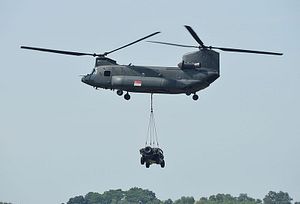On September 8, Singapore announced that its military helicopters had completed an earlier deployment to provide assistance for relief operations following Hurricane Harvey — the first major hurricane to make landfall in the United States in over a decade. It had caused catastrophic flooding in Texas, with dozens of flood-related deaths and thousands of people displaced from their homes.
As I have noted previously, it’s an important manifestation of the extent of U.S.-Singapore defense ties that the Republic of Singapore Air Force (RSAF) has five training detachments in the United States, including the Peace Prairie CH-47 Chinook helicopter detachment in Grand Prairie in Texas which commemorated 20 years of partnership last year (See: “Strengthening US-Singapore Strategic Partnership”).
As a gesture to express appreciation to the United States, Singapore’s Prime Minister Lee Hsien Loong had told U.S. President Donald Trump last week as the latter was en route to Texas that Singapore would deploy four RSAF CH-47 Chinook helicopters to assist with U.S. relief operations in the wake of Hurricane Harvey (See: “Singapore Deploys Military Helicopters for US Hurricane Operations”).
On Friday, Singapore’s defense ministry (MINDEF) officially announced that the four helicopters deployed to Temple, Texas, along with the 34 RSAF personnel, had completed their nine-day deployment, and would return to their training detachment at Grand Prairie, Texas.
According to MINDEF, during the nine-day deployment, which was done in close consultation with the Texas Army National Guard (TXARNG), RSAF transported personnel and essential supplies such as food, water, and equipment as part of broader disaster relief efforts.
TXARNG State Aviation Officer Colonel Ronald Burkett thanked the RSAF personnel for their contributions, not just for their help itself, but for the willingness to deploy as quickly as they did. And Singapore’s Defense Minister Ng Eng Hen chimed in as well, thanking the servicemen for acting as “good ambassadors of goodwill” on behalf of all Singaporeans.
Singapore’s deployment came amidst a series of bilateral defense engagements over the past month that emphasized the breadth and depth of cooperation by both sides. This included the first visit of U.S. Pacific Air Forces Commander Terrence O’Shaughnessy to Singapore just as both sides were carrying out their longest-running air force exercise, Exercise Commando Sling; the annual bilateral exercise with U.S. Marine Corps called Valiant Mark; Singapore’s participation in Exercise Red Flag, the U.S. Air Force’s premier air-to-air combat training exercise; and the holding of the first iteration of the new Exercise Pacific Griffin, the first bilateral naval exercise between the two sides taking place outside of Singapore (See: “What’s in the New US-Singapore Maritime Exercise in Guam?”).
This interaction also comes ahead of Singapore Prime Minister Lee Hsien Loong’s expected visit to the United States for a White House meeting with U.S. President Donald tRUMP later this year (See: “Trump’s Real ASEAN Test”). Lee just had a state visit here last year with former U.S. President Barack Obama, and has already met with Trump on the sidelines of the G20 Leaders’ Summit in Hamburg, Germany, amid the city-state’s lingering anxieties about some aspects of the administration’s policies (See: “The Ticking Clock on Trump’s Asia Strategy”).
Yet this will be Lee’s first White House meeting under the new Trump administration amid an uncertain regional environment in the Asia-Pacific just as Singapore is set to assume the chairmanship of the Association of Southeast Asian Nations (ASEAN) for 2018 from the Philippines who holds it for 2017. Assuming that scheduling issues do not intervene, he will be the third Southeast Asian leader to be granted that honor, after the Vietnamese Prime Minister Nguyen Xuan Phuc and Malaysian Prime Minister Najib Razak who will be in Washington next week (See: “The Real Test for US-Malaysia Relations in the Trump Era”).

































